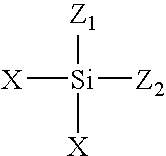Dendrimers of rubbery polymers
a rubbery polymer and dendrimer technology, applied in the field of dendrimers of rubbery polymers, can solve the problems of difficult processing of rubbery polymers prior to vulcanization, poor tensile strength and tear resistance in the unvulcanized state, and the possibility of endlinking up to four polymer chains
- Summary
- Abstract
- Description
- Claims
- Application Information
AI Technical Summary
Benefits of technology
Problems solved by technology
Method used
Image
Examples
example ia
[0036] In a one gallon (3.8 liter) reactor equipped with an air driven stirrer, a nitrogen inlet, and a water cooling coil (inside the reactor) was charged with 2000.0 grams of a 20% monomer mixture of 1,3-butadiene and styrene at a styrene to butadiene ratio of 20:80. Then, 80 mmoles of secondary butylithium and 160 mmoles of tetramethylethylenediamine (TMEDA) were charged into the reactor (targeting a number average molecular weight (Mn) of 5,000. The polymerization temperature was adjusted to 75° C. and after the reaction was completed, the chain ends were still active (living). Then, 400 mmoles of lithium tert-butoxide in hexane solution was added to react with the live ends of the polymer. The contents of the reactor were stirred for five to ten minutes. After that, 80 mmoles of the coupling agent hexachlorodisiloxane was added and the reaction was stirred for an additional ten minutes. The molar ratio of reactants utilized was 1 / 5 / 2 / 1. After the reaction was completed the poly...
example ib
[0037] The same procedure was repeated as in Example IA with the following modifications. In this manner the lithium tert-butoxide was added initially with the butyllithium catalyst and the polymerization was conducted at 75° C. for a target molecular weight of 100,000. The coupling agent was added after the polymerization was completed. The GPC data shows that 46% of the polymer had Mn of 2,070,000 and a functionality of 20.70.
example iia
[0038] The same procedures were repeated as in Example I except the starting number average molecular weight was 1,000. The coupling was employed using the same ratios as in Example I. The isolated polymer was analyzed by GPC and the following results were obtained. The base polymer was a 41% fraction having a Mn of 10,000, fraction 2 represented 12% had a functionality of 2.24, and had a Mn of 22,490, and the third fraction represented 6.93% and had a Mn of 69,360.
PUM
| Property | Measurement | Unit |
|---|---|---|
| temperature | aaaaa | aaaaa |
| temperature | aaaaa | aaaaa |
| particle diameter | aaaaa | aaaaa |
Abstract
Description
Claims
Application Information
 Login to View More
Login to View More - R&D
- Intellectual Property
- Life Sciences
- Materials
- Tech Scout
- Unparalleled Data Quality
- Higher Quality Content
- 60% Fewer Hallucinations
Browse by: Latest US Patents, China's latest patents, Technical Efficacy Thesaurus, Application Domain, Technology Topic, Popular Technical Reports.
© 2025 PatSnap. All rights reserved.Legal|Privacy policy|Modern Slavery Act Transparency Statement|Sitemap|About US| Contact US: help@patsnap.com



